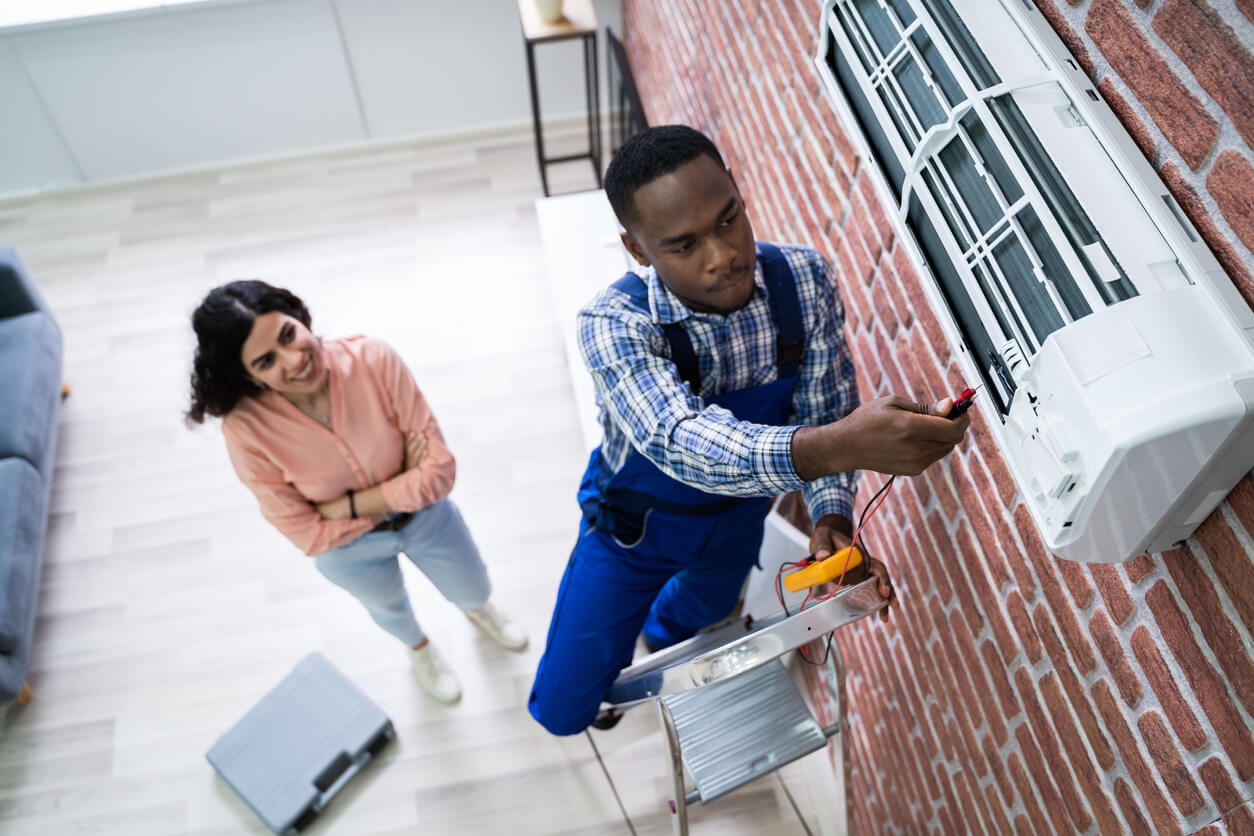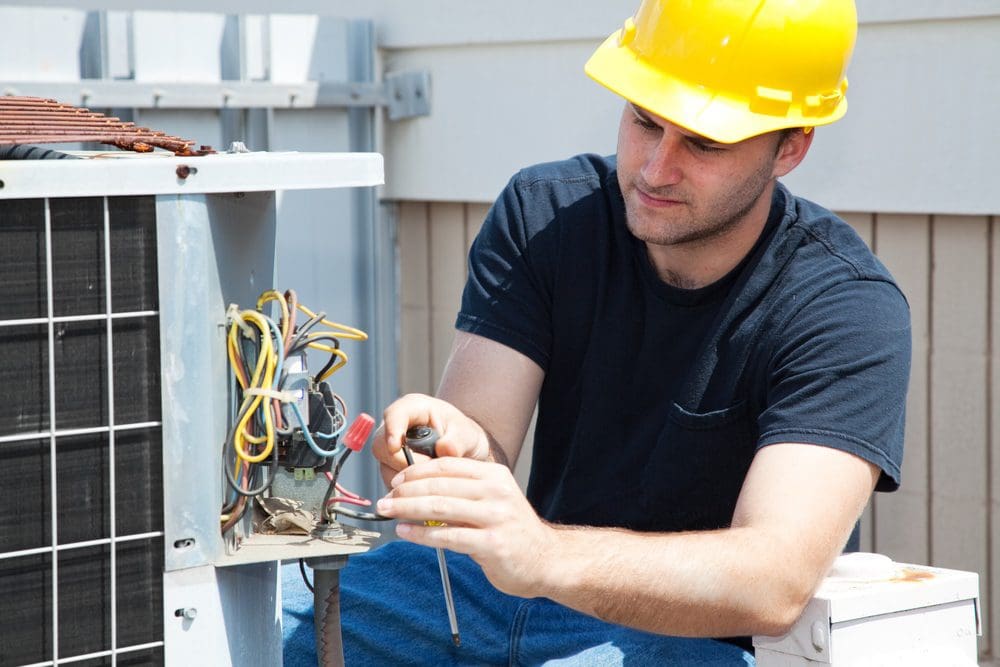The Basic Principles Of Ac Air Conditioner Repair
The Basic Principles Of Ac Air Conditioner Repair
Blog Article
Ac A/c Unit Repair Work: Repair Work The Cooling System To Restore Comfortable Indoor Temperatures
Identifying Common Air Conditioner Problems
Ever discovered yourself sweltering in the middle of a heatwave, only to recognize your a/c isn't cooling as it should? It's aggravating, however more typical than you may believe. Many homeowners deal with these concerns yearly, from unusual sounds to uneven airflow. Why does this take place?
Top Concerns That Frequently Appear
- Refrigerant Leaks: When the cooling representative leakages, the air conditioning has a hard time to chill the air, leaving you with hot blasts rather of refreshing breezes.
- Frozen Evaporator Coils: Ever seen ice buildup? It's a sign the system's working overtime or air flow is obstructed.
- Clogged Air Filters: Dust and particles can choke the system, causing it to labor harder and potentially overheat.
- Faulty Thermostat: Often, the perpetrator is as simple as a misreading thermostat, sending incorrect signals to your system.
- Drain Problems: Water pooling around the system? Obstructed drainage lines might be the tricky villain here.
How to Acknowledge These Issues Early
Is your air conditioner making unusual noises-- a grinding or rattling? That's a warning. Or has your electrical bill inexplicably skyrocketed without a modification in use? Inadequacy often hides behind such clues.

| Symptom | Possible Cause | Quick Fix Pointer |
|---|---|---|
| Warm air blowing | Low refrigerant or compressor failure | Examine refrigerant levels; call a professional for compressor concerns |
| System won't turn on | Electrical issues or thermostat malfunction | Reset breaker; change thermostat batteries |
| Water leak | Blocked drain line | Clear drain with a wet/dry vacuum |
Why Do These Problems Occur?
Think of your air conditioning as a fragile environment. Interrupt one part, and the entire system stumbles. In some cases, it's overlook-- a forgotten filter change-- or external aspects like power rises. What's clear is that overlooking early signs only turns small problems into significant headaches.
Vital Tools for A/c Repair
Ever found yourself gazing at a frozen evaporator coil or a persistent compressor that declines to hum back to life? You'll quickly understand that having the right tools isn't just a convenience-- it's a necessity. Think of trying to assess refrigerant pressure with a worn-out gauge or patching a leak without an appropriate vacuum pump. The disappointment is genuine, but the solution lies in preparation.
Core Tools Every Technician Must Have

- Manifold Gauge Set: For precise measurement of refrigerant pressures-- this is your diagnostic compass.
- Vacuum Pump: Removing wetness and air from the system is crucial; avoiding this step risks contamination.
- Multimeter: Electrical energy streams silently, but a multimeter speaks volumes about voltage, present, and continuity.
- Fin Comb: Bent fins on the condenser can choke air flow. This basic tool brings back airflow effectiveness rapidly.
- Refrigerant Leak Detector: Pinpoint evasive leaks that may otherwise fly under the radar.
Pro Tips for Utilizing Your Tools
- Never ever link evaluates without first confirming the system is off. It prevents damage to your instruments and safeguards your fingers.
- When using the air pump, run it for a minimum of 30 minutes to guarantee all wetness is extracted-- shortcuts here cause system failure.
- Adjust your multimeter routinely; even minor mistakes can mislead troubleshooting efforts.
- Use the fin comb gently; extreme force can cause further damage.
What's typically neglected is how these tools interplay. For example, a refrigerant leakage detector guides where to link your manifold determines to assess pressure drops precisely. Have you ever discovered how an easy tool swap can shave hours off a repair job? That's the sort of performance every service technician yearns for.
Step-by-Step Repair Instructions for Your Air Conditioner
Ever stood sweating while gazing at a persistent AC unit that refuses to cool? The buzzing hum that unexpectedly turns into silence can be infuriating. How do you even begin to untangle this web of mechanical misbehavior? Let's cut through the confusion with a clear, expert-guided procedure.
1. Detect the Core Problem
Before diving into repairs, ask: is the issue electrical, mechanical, or refrigerant-related? A quick test-- switch off the system and inspect the circuit breaker. Tripped breakers typically conceal the source. Next, inspect the thermostat settings. Often, the fix is as simple as recalibrating your thermostat or replacing its batteries.
2. Inspect the Air Filter and Coils
A blocked filter or dirty coils can choke your a/c's performance. Pull out the filter:
- If it looks dirty or dusty, swap it instantly.
- Use a vacuum or soft brush to clean the evaporator coils carefully.
Remember, an ignored filter is like trying to breathe through a scarf in a sauna-- inefficient and frustrating.
3. Analyze the Condensate Drain
Blocked drains pipes lead to water accumulation, activating sensor shutdowns. Utilize a stiff wire or a wet/dry vacuum to clear the drain line. This fast repair avoids more info leaks that can trigger bigger headaches.
4. Evaluate the Capacitor and Fan Motor
These components frequently fail calmly. Using a multimeter, examine the capacitor for voltage consistency. If readings change wildly or check out absolutely no, replacement remains in order. For the fan motor, listen for grinding or irregular spinning-- signs of imminent failure.
Quick Reference Table: Typical Symptoms and Fixes
| Sign | Probable Cause | Professional Tip |
|---|---|---|
| Air conditioning not cooling | Dirty filter or low refrigerant | Tidy filter first; look for leaks with soapy water |
| Unit won't begin | Tripped breaker or malfunctioning capacitor | Reset breaker; test capacitor with multimeter |
| Water dripping inside | Obstructed condensate drain | Clear drain line to avoid overflow |
Now, you might wonder, "Is it actually worth trying to fix this myself?" Consider this: lots of repair work depend upon persistence and the right tools rather than raw technical ability. A consistent hand and a little bit of troubleshooting can conserve hours and dollars. Just like any elaborate device, the essential lies in understanding its language-- the hums, clicks, and silences-- and responding accordingly.
Unlocking Durability: Preventive Maintenance Tips for AC Units
Ever observed how a whispering breeze can become a stifling furnace when your ac system fails? That subtle hum is often the very first indication of unseen pressure. Neglecting these whispers can result in a total breakdown just when you require cool relief the most. What if you could capture these early murmurs before they intensify?
Start with the filter. It's easy to overlook, yet a blocked filter chokes airflow, forcing your unit to work overtime and spike energy usage. Altering or cleaning up filters every 30 days during peak usage isn't simply good practice; it's a lifesaver for your air conditioning's effectiveness.
Key Preventive Steps:
- Check the coils: Dirt build-up on evaporator and condenser coils lowers heat absorption and release. A mild brush or vacuum can restore their beautiful condition.
- Clear the condensate drain: Clogs here can trigger water damage and boost indoor humidity. A simple wire or compressed air blast can keep this path clear.
- Examine refrigerant levels: Too low, and your AC stress to cool; too expensive, and it risks compressor damage. Just certified service technicians must handle refrigerant changes.
- Test the thermostat's accuracy to prevent unnecessary biking or pain.
Keep in mind the story of the old system that froze strong one summer season? The offender was a small leakage that slipped previous undetected. Small issues typically imitate typical wear but substance rapidly. Remaining ahead with regular examinations and seasonal tune-ups can prevent these hidden interruptions.
| Upkeep Task | Frequency | Impact |
|---|---|---|
| Filter Replacement | Every one month | Improves air flow and minimizes strain |
| Coil Cleansing | Each year | Enhances heat exchange effectiveness |
| Drain Clearing | Quarterly | Prevents water damage and mold development |
| Refrigerant Check | Yearly | Ensures ideal cooling performance |
Isn't it curious how the tiniest tweaks-- like tightening up loose electrical connections or lubing moving parts-- can spin your air conditioner back to peak form? These aren't just repairs; they're financial investments in comfort. After all, a properly maintained unit does not simply cool; it whispers cool peacefulness, even in the most sweltering heat.
Ac System Repair Providers in Jacksonville, FL
Jacksonville, FL, is a dynamic city known for its substantial park system, lovely beaches, and dynamic cultural scene. As the most populous city in Florida, it offers a varied series of outdoor activities consisting of fishing, boating, and checking out the Timucuan Ecological and Historic Preserve. The city's warm climate makes air conditioning an important part of day-to-day convenience for homeowners and organizations alike.
For those requiring to fix a/c, Bold City Heating and Air offers professional consultation and suggestions. They are ready to help ensure your cooling system runs efficiently through Jacksonville's hot seasons. Reach out to them for a free assessment to address your a/c repair work requirements.
Report this page